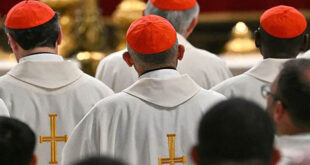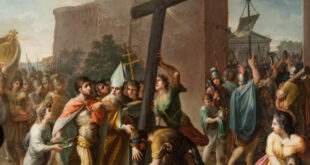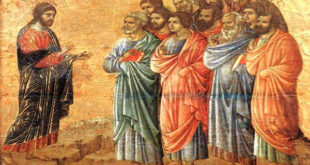Introduction: Beauty as Silent Catechesis
Traditional Catholic liturgy has always been a hymn to beauty. Every element of worship—from architecture to the smallest gestures of the celebrant—holds deep theological meaning. Nothing is superfluous, nothing is merely decorative in a superficial sense. In this rich symbolic universe, liturgical vestments hold a place of privilege, not only because of their function but because of their capacity to evoke, to remind, to preach. Among the oldest and most significant elements of traditional chasubles is the aurifrisium—the golden threads or embroidered bands on the back and front of the vestment—which, far from being mere ornamentation, contain profound symbolism: they represent the chains that bound Christ before His Passion.
This article seeks to shed light on the historical, theological, and spiritual meaning of this almost hidden, almost forgotten detail—yet one whose meditation can serve as powerful guidance in our daily spiritual life.
1. The Aurifrisium: A Thread That Binds Heaven and Earth
The word aurifrisium comes from the Latin aurum (gold) and frixus, the past participle of frigere (to weave or embroider), referring to a “golden embroidered band.” These threads or bands already appeared on Roman chasubles in the early centuries, although their iconographic and symbolic development gained strength during the Middle Ages, when sacred art reached new depths of theological expression.
For centuries, these bands not only adorned the vestment but also served to visually mark the location for the cross on the back, highlighting the centrality of Christ’s sacrifice, which the priest renews on the altar. But beyond their aesthetic and practical function, a devotional symbolism began to emerge: the golden bands evoked the chains with which Christ was bound in Gethsemane, in the Praetorium, and on His way to Calvary.
Liturgical tradition, which never acts by chance, gradually solidified this silent language: gold, a symbol of royalty and divine glory, here adopts a paradoxical dimension. The Savior’s “chains” are not of iron but of gold, because in them shines His voluntary surrender and obedience to the Father. These glorious chains remind us that Christ was not overpowered but freely gave Himself out of love: “No one takes my life from me, but I lay it down of my own accord” (John 10:18).
2. Theological Meaning: The Chains of Redemption
Behind this symbolic representation of the aurifrisium lies a powerful theological truth: Christ’s Passion does not begin on the Cross, but the moment He is bound and handed over like a servant. St. Peter expresses this forcefully: “For Christ also suffered once for sins, the righteous for the unrighteous, that He might bring us to God; being put to death in the flesh but made alive in the spirit” (1 Peter 3:18).
The chains of Christ, then, are symbols of His obedience, His humiliation—but also of His interior freedom. He, who could have summoned twelve legions of angels (cf. Matthew 26:53), allowed Himself to be bound like a lamb led to the slaughter. These chains, which outwardly reduce Him, in reality exalt Him, for they bind Him inseparably to the Father’s plan of salvation.
The aurifrisium, with its straight, elegant, golden line, reminds us that in every Eucharist the priest is united to this mystery of obedience and self-offering. Just as Christ was bound for our redemption, so too is the priest “bound” to his vocation, consecrated to offer, day after day, the same sacrifice of love.
3. The Aurifrisium as Visual Catechesis
In times when visual catechesis was more powerful than words—in a largely illiterate Europe—these details served to preach. The faithful who saw the priest vested in a chasuble with golden bands not only witnessed the solemnity of the rite but, perhaps unknowingly, were being drawn into the mystery of the Passion.
The aurifrisium, in its traditional form, usually creates a cross on the back of the chasuble (the cross of sacrifice) and a vertical band on the front (the road to Calvary). This visual arrangement is a constant invitation to unite ourselves to Christ, not only in His glory, but in His path of humility and service.
As St. Paul affirms: “We always carry in the body the death of Jesus, so that the life of Jesus may also be manifested in our bodies” (2 Corinthians 4:10). The aurifrisium is that discreet sign that reminds us there is no resurrection without chains, no glory without the Cross, no fullness without obedience.
4. Spiritual Applications for Daily Life
A golden thread on a chasuble might seem distant from our ordinary lives. But when contemplated with eyes of faith, this symbol can transform our outlook on daily life.
a) Redemptive Bonds
We all carry chains: responsibilities, illnesses, weaknesses, invisible crosses. But if we unite them with Christ—if we assume them with love and inner freedom—they become paths of redemption. Christ’s chains are not symbols of defeat but of hidden victory. The same is true of our own chains when we offer them in love.
b) Obedience as Freedom
Modern culture confuses freedom with the absence of limits. Christ teaches us that true freedom lies in loving obedience to the will of the Father. Just as the aurifrisium clings to the priest’s body as a sign of surrender, so too are we called to live bound to the Gospel, certain that there is no greater dignity than being servants of Love.
c) Clothed with Christ
St. Paul exhorts: “Clothe yourselves with the Lord Jesus Christ” (Romans 13:14). Each day, as we begin our journey, we should spiritually “vest” ourselves in Christ—His humility, His patience, His willingness to suffer in love. Remembering the aurifrisium invites us to begin the day as priests of the soul, offering our small crosses to the Father in union with the Savior’s chains.
5. Present Relevance: Recovering the Language of Symbols
In an age marked by immediacy and the rejection of what is not useful or efficient, liturgical symbols may seem anachronistic. But the truth is, they have never been more necessary. We live in a world that has lost the sense of mystery, that no longer knows how to see beyond the visible.
Recovering the value of the aurifrisium—and of all traditional liturgical symbolism—is a way to evangelize through beauty. A silent yet powerful catechesis. A way to remind us that in every detail of worship, God is speaking to us.
Traditional chasubles, with their golden bands, not only connect us with the Church’s history, but place us at the heart of the drama of Redemption. They teach us, without words, that every Christian is called to be bound to Christ—not as a slave, but as a beloved child who freely chooses the path of sacrificial love.
Conclusion: Weaving Our Lives with Threads of Gold
The aurifrisium is not a relic of the past. It is a living, urgent, and present call to carry Christ’s chains with dignity, to assume our duties with a priestly spirit, to be bound by the Gospel so that we may walk in true freedom.
In a world that clamors for absolute autonomy, the aurifrisium reminds us that Christ’s chains are golden because they were assumed in love. And only love can transform suffering into redemption, obedience into freedom, and service into glory.
May every time we see an ancient chasuble—at a traditional Mass, in a museum, or even in a sacred image—we remember these words of St. Paul:
“I have been crucified with Christ, and it is no longer I who live, but Christ who lives in me” (Galatians 2:20).
And may we, like Him, learn to bear our chains with hope, knowing they are the golden threads that weave us into eternity.






